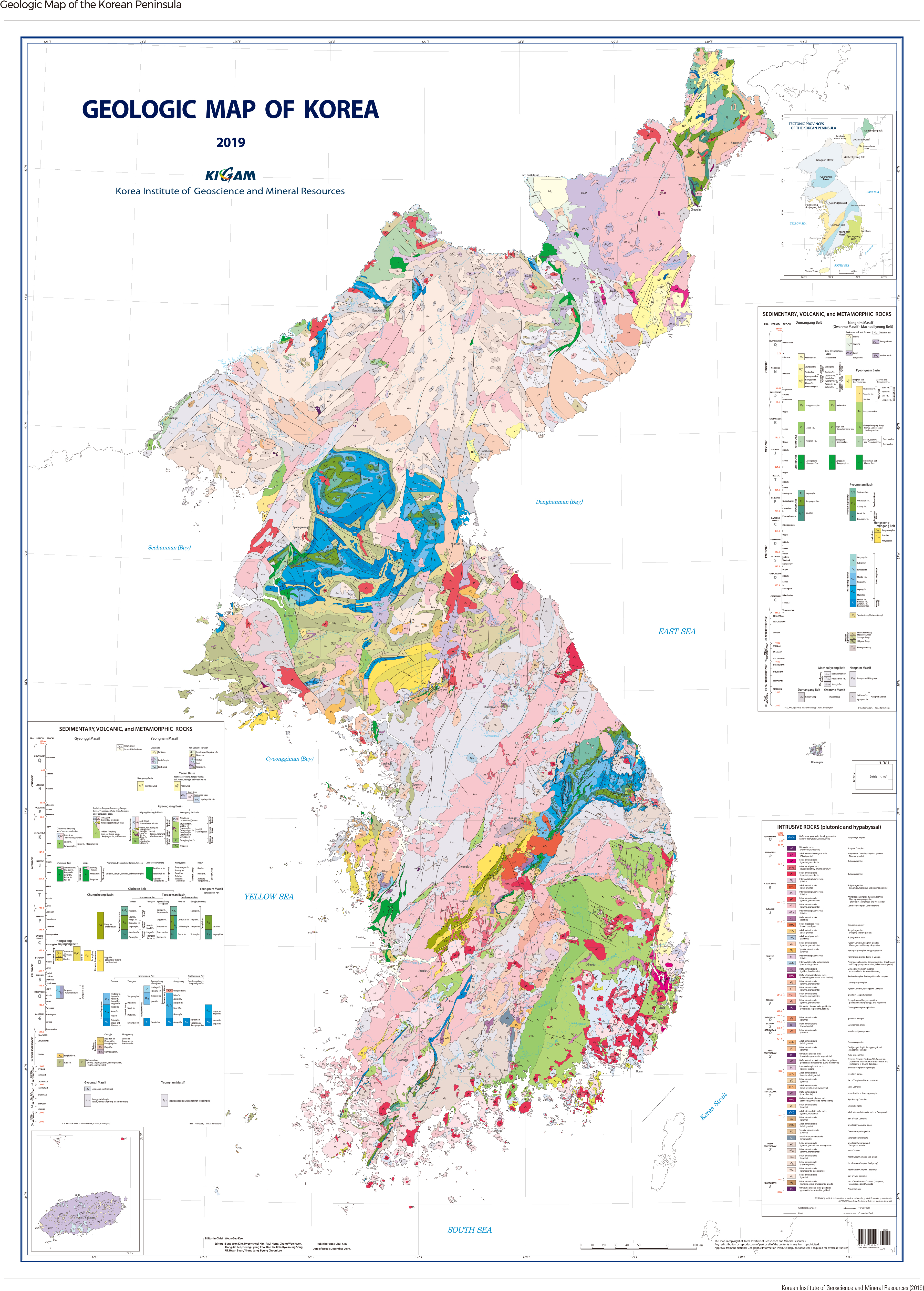English II 2020
On the Korean Peninsula, the oldest rocks are Neoarchean meta-igneous rocks ca. 2.5 Ga. Older rocks were recycled through the rock cycle into Paleoproterozoic metasedimentary and igneous rocks ca. 2.0–1.8 Ga. The Paleoproterozoic rocks make up the foundation of the Korean Peninsula and are classified, from north to south, into the Gwanmo, Nangrim, Gyeonggi, and Yeongnam Massifs.
The Paleozoic Imjingang belt, which developed in the east-west direction along the Imjingang to the Chugaryeong Graben, divides the Gwanmo-Nangrim and Gyeonggi Massifs. The Gwanmo-Nangrim Massif runs through Hamgyeong-do, Pyeongan-do, northern Gangwon-do, and Hwanghae-do. The Gyeonggi Massif runs through Gyeonggi-do, Chungcheong-do, and southern Gangwon-do. The Gyeonggi and Yeongnam Massifs are divided by the Neoproterozoic-Paleozoic Ogcheon belt, which extends northeastward from Jeollanam-do to Gangwon-do. The Yeongnam Massif runs through Jeolla-do and Gyeongsang-do. Okcheon belt consists of the Taebaeksan Basin, which is distributed from Gangwon-do to Haenam, Jeollanam-do, and the Okcheon metamorphic belt, which is mainly distributed in Chungcheongnam-do and Chungcheongbuk-do.
Paleoproterozoic metamorphic and igneous rocks in the Korean Peninsula formed at a depth of about 35 km are now exposed at the surface due to tectonic uplift and erosion. Paleoproterozoic metamorphic and igneous rocks were covered in unconformity by metamorphic sedimentary rocks (Seosan Group) formed in the Late Paleozoic era (1.80–1.76 Ga) and were subsequently intruded by granite formed in the Paleoproterozoic era (1.76–1.70 Ga). These rocks were intruded by the Mesozoic igneous rocks (1.25–1.19 Ga), and these rocks are mainly distributed along the west coast, in Hongseong, Chungcheongnam-do, and Hwanghae-do.
Neoproterozoic rocks are widely distributed in the southern part of the Nangrim Massif between Haeju and Wonsan and consist mostly of sedimentary rocks, which was intruded by igneous rocks in some areas. Neoproterozoic rocks were recently discovered in the area adjacent to the Imjingang belt, Hongseong in Chungcheongnam-do, and the northeastern Ogcheon metamorphic belt.
Paleozoic sediments are widely found in the Pyeongnam Basin in Pyeongannam-do and Pyeonganbuk-do, the Taebaeksan Basin distributed from Gangwon-do to Jeollanam-do, and the Ogcheon metamorphic belt. They are also found in the Imjingang belt, the northeastern Hamgyeong-do, and the western part of the Gyeonggi Massif. The Pyeongan and Taebaeksan Basins consist of the Chosun and Pyeongan Supergroups; the Chosun Supergroup was deposited between the Cambrian and Early Silurian, and the Pyeongan Supergroup was deposited unconformably on the Chosun Supergroup between the Middle Carboniferous and Permian. The Chosun Supergroup consists of marine sediments, primarily limestone. The Pyeongan Supergroup mainly consists of continental sediments and contains a lot of coal. Devonian sediments are found in the Imjingang belt. The Okcheon metamorphic belt and the Paleozoic sedimentary rocks in the western Gyeonggi Massif appear to have been deposited after the Ordovician period. Recent studies, however, suggest that some of them deposited during the Permian period.
The Duman Supergroup in northeastern Hamgyeong-do consists of Carboniferous-Permian sediments. Late Paleozoic igneous rocks are found in northeastern Hamgyeong-do and are also reported in the Hongseong and Mungyeong areas.
On the Korean Peninsula, Triassic and Jurassic sedimentary rocks occur only locally in limited areas. However, cretaceous sediments of the Gyeongsang Supergroup are widely distributed in Jeolla-do and Gyeongsang-do. The Gyeongsang Supergroup consists of non-marine sediments deposited in the lake, which provided a good habitat for dinosaurs. Consequently, many dinosaurs lived on the Korean Peninsula, leaving abundant fossils in the Cretaceous sedimentary layers, including footprints and eggs and bone fossils. From the Late Permian to the Cretaceous, there was a subduction zone around the Korean Peninsula, and subduction-related igneous rocks regionally intruded the Korean Peninsula. There was an extensive igneous intrusion during the Jurassic, forming the Daebo Granite, which comprises the main foundation of the Korean Peninsula along with Paleoproterozoic rocks.
A recent study shows that Triassic granites formed due to a continental collision within the Korean Peninsula are mixed in with Jurassic granites in the northern Gyeonggi Massif. Further evidence of Triassic continental collision is provided by the Triassic eclogite found in the area of Hongseong. The Jurassic granites, which formed at a depth of around 15 km, are directly covered with Cretaceous volcanic and sedimentary rocks. These facts indicate the uplift of the Korean Peninsula before the Cretaceous.
During the Cenozoic, the East Sea was formed, separating Japan from Korea and uplifting the eastern part of the Korean Peninsula higher than the western part, resulting in westward tilting. The Baekdusan, Ulleungdo, Dokdo, Jejudo volcanoes, and the Chugaryeong Graben also formed during the Cenozoic with the Cenozoic sedimentary rocks in Hamgyeong-do and Pohang.
Recently Korean researchers have expanded the scope of research to overseas geology. As a result, mining rights for manganese nodules in the Pacific Ocean (1994), exploration rights for hydrothermal deposits in Tonga and Fiji (2008, 2011), and mining rights for hydrothermal deposits in the Indian Ocean (2012) were acquired, and the geologic map of Suai in East Timor was made. In 1987, Korea began research on the polar regions. |
